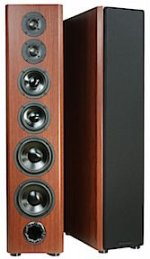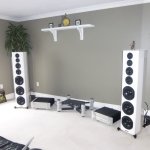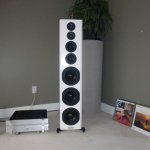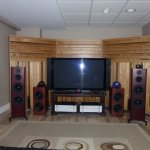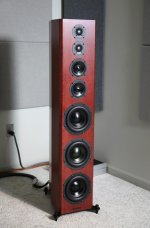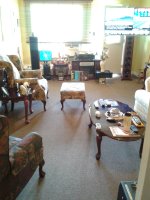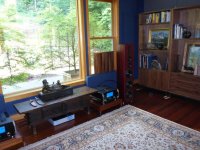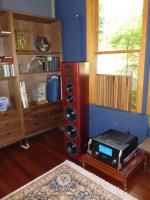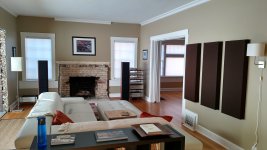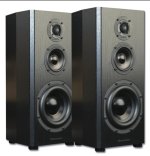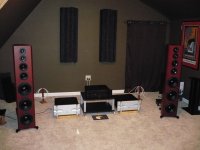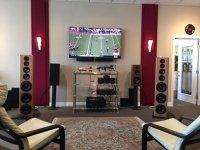MEMO: To All Bryston Customers
SUBJECT: Bryston –Model T Speakers – Dealer Feedback
September 2016
Observations on Bryston Model T Signature Speakers
Matrix One Management Consulting Inc.
I've had the Model T Signature speakers for some time now, and so have had ample opportunity to become familiar with them. The arrival of the Model T’s happened to coincide with a move into a new house, and consequently a new listening room, so I had to get to know not only the speakers, but the new rooms’ characteristics as well. The room is roughly 18 ft. wide by 25 ft. long, with a 10-1/2 ft. ceiling height, and is architecturally symmetrical, with the exception of a small area in the left rear corner that bumps out beyond those dimensions. A fair room volume, but the Model T's are more than able to provide satisfying volume & dynamics at any sane listening level.
With enough listening hours under the belt, I now feel that I know what the room is like, and therefore what the Model T's are bringing to the party.
Some background: I've been involved with the audio industry all of my working life, and I've been privileged to experience some incredible examples of sound reproduction along the way. At one time I was employed by Harry Pearson, and worked for the Absolute Sound magazine in Sea Cliff, NY, involving nearly daily exposure to Harry's continuously-changing reference systems (including the then-famed Infinity Reference System). In more recent years I've served as lead project consultant for upscale private theaters.
When James Tanner gave me the run-down on the design path for the Model T's, they sounded intriguing, but I was concerned that they would have enough output to work well in my new room, given its volume. I needn't have worried. Driven by a pair of 7B's, the Model T's can reach beyond what my room can handle, whether it's T-Rex or Tchaikovsky. They can play loud, while maintaining linearity & detail even in the low frequencies. Within reason, your room and its loading and modal characteristics are more likely to be a limiting factor than the Model T’s.
If you’ve read the professional reviews, you already know that the speakers go loud, are extended in the basement frequencies relative to their size and driver complement, and are generally linear in their frequency response and polar patterns.
I feel that the performance of the Model T's is especially noteworthy for a few reasons.
Transparency
While I won't claim that I've never heard more transparent reproducers, the Model Ts are excellent for speakers that use passive crossovers & dynamic drivers. The differences between recording techniques, mixing and mastering are audible, including sophisticated mastering tools such as multi-band compression. There is no upper-low frequency bump that some designs use to give an exaggerated and inaccurate impression of power in the bottom end. But there is low-end power and extension, in proportion to what is on the recording. Low organ notes down to what I’d judge as being in the 24Hz area are reproduced cleanly and distinctly, and with appropriate authority, frequencies below taper off, rather than soundling like they fall off the proverbial cliff. Electric bass in well-mixed modern recordings is a particular treat, as the Model T’s never sacrifice transient or dynamic detail or contrast for “bloat”.
With recordings that incorporate real ambient space, such as The Weavers Reunion At Carnegie Hall 1963 / Ramblin’ Boy, the acoustic space of the old Carnegie Hall is palpable, and is great fun to hear. Significantly, I hear that space to evenly occupy the same “virtual stage” as the voices and instruments; it’s not that it sounds most obvious between the speakers and weakens toward the boundaries of the audible sound stage. The ambient cues sound like you could be really hearing it in the depth, breadth & height of the Carnegie Hall stage. Such ambient space sounds different from reverb added in post, no matter how refined the reverb algorithm is.
Sound Space
The Model T’s in my room are surprisingly satisfying in terms of perceptual width, height and perhaps, to a slightly lesser extent, depth of the musical stage. (I say perhaps as what I’m hearing may well be more a function of the room’s influence, than the speakers. It may also be related to digital sources, my records are still in boxes.) Maybe it’s that the sound space so easily and so clearly extends beyond the width and height of the speaker placements, that the illusion of depth is merely good by comparison. Sounds do appear both forward of and behind the plane of the speakers. In multi-tracked pop recordings, perceived depth is an artifact of such enhancements as reverb, delay, relative mix levels between tracks, and so on. The Model T’s let you hear these nuances, and in a way, occasionally also lets you hear their respective limitations. I mean as contrasted with a sense of depth captured “live” in one pass, in a real acoustical space, with minimal compression in post, and with simple microphone placements intended to capture both direct and indirect sounds.
Dynamics
Those who know me can tell you that I have reservations about speakers designed for the retail consumer market, in terms of dynamic capabilities. More often than not, and across many brands, such designs will sound good to varying degrees in store showrooms, but fall apart when placed in a use-scenario that requires wide dynamic range, fast response times to high-level transients, and significant peak volumes, without what sounds like compression from the monitors themselves. In casual use, we don’t notice this much, as the vast majority of popular and even most classical recordings are compressed in mastering, and don’t place significant demands on the audio chain. The best recordings, however, and certainly some film soundtracks, do.
When you place many of these models, intended for consumer living rooms, into a space that is acoustically designed and reasonably damped (strategic use of absorbing & reflecting materials), and without the crutch of reflections from walls & ceilings, they often don’t perform when things are meant to get exciting.
Monitors designed for the pro recording & mastering spaces are typically much better in this regard, to the extent that historically, when spec’ing a customer’s private theater, I’ve preferred to avoid consumer designs.
But no worries here. The Model T’s have very good dynamics. Although I don’t play music or movies at levels that would induce pain, I have yet to hear them artificially compress or otherwise sound unhappy. Overall dynamic range (large dynamics) is far superior to the majority of consumer speakers, including some that cost much more, and micro contrasts are well reproduced, if not at the level of the very best I’ve ever heard over the years (my fondest memories come from heavily modified or unique special designs that were never commercially available).
Bang for the Buck
If I had to peg one thing and one thing only that makes the Model T’s important, it would be this: they are unbelievable value for money. Period.
Have more money to spend? Great. But you need a quite a lot more money.
When I ordered the Model T’s, I was hoping for something that would manage satisfying volume levels in my room, which serves for both movies and music. I was hoping for a certain baseline of performance in terms of listening quality, but really thought that the speakers and their driver complements might barely manage in my room. My first love is music, but honestly, I imagined the total result would be very good for movies, and merely good for music listening.
The Model T Signatures have far exceeded my expectations.
Movies do indeed sound very good, but music listening now takes pride of place.
Thank you,
Bryston.
Brian Gammon
